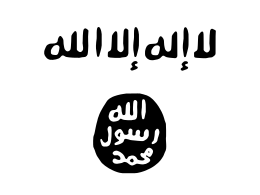طالبان پاکستان
ظاهر
(تغییرمسیر از جنبش طالبان پاکستان)
| تحریک طالبان پاکستان | |
|---|---|
  پرچمهای مورد استفاده تحریک طالبان[۱] | |
| رهبران | بیتالله محسود †[۲] (۲۰۰۷–۰۹) حکیمالله محسود †[۳][۴] (۲۰۰۹–۱۳) فضل حیات †[۵] (۲۰۱۳–۱۸) نور ولی محسود (از ۲۰۱۸) |
| تاریخ فعالیت | دسامبر ۲۰۰۷ – اکنون |
| وفاداری | |
| مقر | شرق افغانستان[۷][۸][۹][۱۰][۱۱][۱۲] |
| ایدئولوژی | وهابیت[۱۳] بنیادگرایی اسلامی[۱۴][۱۵][۱۶][۱۷] پشتونوالی[۱۸] فرقهگرایی[۱۹] جداییخواهی[۲۰][۲۱][۲۲][۲۳] |
| اندازه |
|
| متحدان | |
| مخالفان | |
| درگیریها و جنگها | شورش خیبر
جنگ در افغانستان (۲۰۰۱–۲۰۲۱) جنگ داخلی سوریه |
| اعلامشده بهعنوان گروه تروریستی از سوی | |
جنبش طالبان پاکستان (TTP) که معمولاً طالبان پاکستان نامیده میشود، سازمانی فراگیر از گروههای شبهنظامی اسلامگرا است که در شمالغربی پاکستان، در مناطق قبیلهای فدرال در طول مرز افغانستان مستقر هستند.
مرگبارترین حمله تروریستی تاریخ پاکستان
[ویرایش]در صبح روز ۱۶ دسامبر ۲۰۱۴ (۲۵ آذر ۱۳۹۳) پنج مهاجم طالبان در حالیکه یونیفورم ارتش پاکستان را بر تن داشتند، وارد ساختمان یک مدرسه وابسته به ارتش در شهر پیشاور شدند و ۱۴۹ تن از جمله ۱۳۳ دانشآموز را کشتند و ۱۲۲ تن دیگر را زخمی کردند. اغلب دانشآموزان این مدرسه فرزندان نظامیان ارتش بودند. طالبان هدف از این حمله را انتقامگیری از خانواده نظامیان ارتش عنوان کرد.[۴۳] نواز شریف نخستوزیر پاکستان این حمله را مرگبارترین حمله تروریستی تاریخ کشورش و عزای عمومی اعلام کرد.[۴۴]
منابع
[ویرایش]- ↑ "New video message from the Teḥrīk-ī-Ṭālibān Pākistān's Abū Manṣūr 'Āṣim Meḥsūd: 'About the Messages of Condolence and Congratulation Sent By the Leaders of the Islamic Jihād on the Occasion of the Martyrdom of Mawlawī Faḍl Allah Khurāsānī and a Petition to the Jihādī Leaders To Unite the Blessed Jihādī Ranks'". jihadology.net. Archived from the original on 9 August 2019. Retrieved 11 September 2019.
- ↑ Abbas, Hassan (January 2008). "A Profile of Tehrik-I-Taliban Pakistan". CTC Sentinel. West Point, NY: مرکز مبارزه با تروریسم. 1 (2): 1–4. Archived from the original on 1 January 2017. Retrieved 8 November 2008.
- ↑ "Hakeemullah announced new leader – doubts linger". Dawn News. 23 August 2009. Archived from the original on 26 August 2009. Retrieved 23 August 2009.
- ↑ Khan, Hasbanullah (23 August 2009). "Hakeemullah appointed Baitullah's 'successor'". Daily Times. Archived from the original on 9 November 2009. Retrieved 24 August 2009.
- ↑ "Isis ascent in Syria and Iraq weakening Pakistani Taliban". گاردین. London. 23 October 2014. Archived from the original on 22 October 2014. Retrieved 24 October 2014.
- ↑ Thomas Joscelyn (19 August 2021). "Pakistani Taliban's emir renews allegiance to Afghan Taliban". FDD's Long War Journal.
- ↑ "Kabul Taliban: Spies, militants and a mysterious assassination". BBC News. 7 February 2020. Archived from the original on 7 February 2020. Retrieved 7 February 2020.
The group, which has been severely weakened in recent years, is now based in the east of Afghanistan, in areas out of the control of the country's government.
- ↑ "The Rise Of The New Pakistani Taliban". RFE/RL (به انگلیسی). 18 May 2021.
- ↑ ۹٫۰ ۹٫۱ "Pak's TTP Maintains Ties With Taliban, Its 6,000 Terrorists Still In Afghanistan: UN Report". NDTV.com. 27 July 2021.
- ↑ "TTP has foothold in Afghanistan, says Abdullah". Dawn News. 17 November 2017. Archived from the original on 17 November 2017.
- ↑ Zia ur Rehman (18 April 2019). "Pakistani Taliban: Between infighting, government crackdowns and Daesh". TRT World. Archived from the original on 18 April 2019.
- ↑ Franz J. Marty (9 April 2018). "Afghan-Pakistani Cross-Border Terrorism Cuts Both Ways". The Diplomat. Archived from the original on 18 May 2018.
- ↑ ۱۳٫۰ ۱۳٫۱ "Did you know that there are two different Taliban groups?". www.digitaljournal.com. 1 April 2013.
- ↑ ۱۴٫۰ ۱۴٫۱ "Tehrik-i-Taliban Swat/Bajaur/Mohmand". DOPEL. Archived from the original on 24 September 2016. Retrieved 12 December 2018.
- ↑ ۱۵٫۰ ۱۵٫۱ Maley, William (2001). Fundamentalism Reborn? Afghanistan and the Taliban. C Hurst & Co. p. 14. ISBN 978-1-85065-360-8.
- ↑ ۱۶٫۰ ۱۶٫۱ "Taliban - Oxford Islamic Studies Online". Archived from the original on 31 May 2019. Retrieved 11 September 2019.
- ↑ "Deobandi Islam: The Religion of the Taliban". U.S. Navy Chaplain Corps, 15 October 2001.
- ↑ ۱۸٫۰ ۱۸٫۱ "Understanding taliban through the prism of Pashtunwali code". CF2R. 30 November 2013. Archived from the original on 10 August 2014. Retrieved 18 August 2014.
- ↑ ۱۹٫۰ ۱۹٫۱ "MMP: Tehrik-i-Taliban Pakistan". cisac.fsi.stanford.edu (به انگلیسی).
- ↑ ۲۰٫۰ ۲۰٫۱ Shane, Scott (22 October 2009). "Insurgents Share a Name, but Pursue Different Goals". نیویورک تایمز. Archived from the original on 16 October 2012. Retrieved 26 January 2011.
- ↑ ۲۱٫۰ ۲۱٫۱ Siddiqa, Ayesha (2011). "Pakistan's Counterterrorism Strategy: Separating Friends from Enemies" (PDF). The Washington Quarterly. 34 (1): 149–162. doi:10.1080/0163660X.2011.538362. S2CID 54884433. Archived from the original (PDF) on 24 December 2010. Retrieved 8 February 2011.
- ↑ ۲۲٫۰ ۲۲٫۱ Elias, Barbara (2 November 2009). "Know Thine Enemy". Foreign Affairs. Archived from the original on 20 November 2009. Retrieved 11 February 2011.
- ↑ ۲۳٫۰ ۲۳٫۱ "4 Pakistani soldiers killed in separate clashes". Anadolu Agency. Retrieved 14 January 2021.
- ↑ Bennett-Jones, Owen (25 April 2014). "Pakistan army eyes Taliban talks with unease". بیبیسی نیوز. Archived from the original on 25 April 2014. Retrieved 4 July 2014.
- ↑ "Lead Inspector General for Operation Freedom's Sentinel I Quarterly Report to the United States Congress I January 1, 2019 – March 31, 2019". Department of Defense Office of Inspector General (DoDIG). Archived from the original on 1 June 2019. Retrieved 12 May 2019.
- ↑ "The Pakistani Taliban is Back". The Diplomat. 9 March 2021.
- ↑ خطای یادکرد: خطای یادکرد:برچسب
<ref> غیرمجاز؛ متنی برای یادکردهای با نامnwsوارد نشده است. (صفحهٔ راهنما را مطالعه کنید.). - ↑ "Is ISIS coming to Pakistan? TTP and ISIS join hands". Parhlo. 16 October 2014. Archived from the original on 15 July 2015.
- ↑ "Tehreek-e-Nafaz-e-Shariat-e-Mohammadi, Extremist Group of Pakistan". SATP. Archived from the original on 2007-05-25. Retrieved 2007-04-19.
- ↑ Giustozzi, Antonio (2018). The Islamic State in Khorasan: Afghanistan, Pakistan and the New Central Asian Jihad. انتشارات دانشگاه آکسفورد. pp. 137–138. ISBN 978-1-84904-964-1.
- ↑ Shehzad, Mohammad (10 March 2006). "Why is the Pakistan army scared of this man?". in.rediff.com. rediff. Archived from the original on 16 December 2007. Retrieved 14 December 2020.
بیتالله محسود was appointed as ملا عمر's governor of the Mehsud tribe in a special ceremony attended by five leading Taliban commanders
- ↑ Gall, Carlotta (26 March 2009). "Pakistan and Afghan Taliban Close Ranks". نیویورک تایمز. Islamabad, Pakistan. Retrieved 14 December 2020.
The Afghan Taliban delegation urged the Pakistani Taliban leaders to settle their internal differences, scale down their activities in Pakistan and help counter the planned increase of American forces in Afghanistan, the fighters said.
- ↑ Zahid, Farhan (15 April 2019). "Profile of New TTP Chief Mufti Noor Wali Mehsud: Challenges and Implications" (PDF). pakpips.com. Islamabad, Pakistan: Pak Institute for Peace Studies. p. 4. Retrieved 14 December 2020.
According to Mehsud, the real jihad is against US forces in occupied Afghanistan to restore the Islamic Emirate while using tribal areas of Pakistan as base of operations and safe haven for both Taliban and Al-Qaeda. He further explains the goals and aims of the jihadi movement as: maintaining the independent status for Mehsud tribe, defeating the US in Afghanistan, establishing caliphate in Afghanistan
- ↑ Roggio, Bill (12 July 2021). "Taliban advances as U.S. completes withdrawal". FDD's Long War Journal. Archived from the original on 24 July 2021. Retrieved 16 July 2021.
- ↑ K J M Varma (5 July 2021). "Insurgent groups against Pakistan, China step up attacks amid Taliban offensive in Afghanistan: Report". Yahoo. Archived from the original on 18 July 2021. Retrieved 18 July 2021.
During the recent fighting in eastern and southern districts of Afghanistan, the Afghan Taliban has been supported by the TTP insurgents [...] According to a UN monitoring report in June, some 5,000 TTP militants are currently based in Afghanistan.
- ↑ Tom Wheeldon (18 August 2021). "Pakistan cheers Taliban out of 'fear of India' – despite spillover threat". فرانس ۲۴.
The Afghan militants' closeness to Pakistani jihadist group Tehrik-e-Taliban (TTP or, simply, the Pakistani Taliban) is a particular source of concern. The TTP have carried out scores of deadly attacks since their inception in the 2000s, including the infamous 2014 Peshawar school massacre. The Taliban and the TTP are 'two faces of the same coin', Pakistani Army Chief General Qamar Javed Bajwa and ISI boss Lieutenant General Faiz Hameed acknowledged at an off-the-record briefing in July. Indeed, the Taliban reportedly freed a senior TTP commander earlier this month during their sweep through Afghanistan. 'Pakistan definitely worries about the galvanising effects the Taliban's victory will have on other Islamist militants, and especially the TTP, which was already resurging before the Taliban marched into Kabul,' Michael Kugelman, a South Asia expert at the Wilson Center in Washington, DC, told FRANCE 24. 'It's a fear across the establishment.'
{{cite web}}: External link in|quote= - ↑ "Pakistan Taliban splinter group vows allegiance to Islamic State". 18 November 2014. Retrieved 13 May 2015.
- ↑ "Taliban assure it won't allow TTP to use Afghan land against Islamabad: Pakistan government".
{{cite news}}: نگهداری CS1: url-status (link) - ↑ Tahir Khan (25 August 2021). "14 dead in TTP-Afghan Taliban clash". The Express Tribune. Archived from the original on 25 August 2021.
- ↑ خطای یادکرد: خطای یادکرد:برچسب
<ref> غیرمجاز؛ متنی برای یادکردهای با نامustوارد نشده است. (صفحهٔ راهنما را مطالعه کنید.). - ↑ خطای یادکرد: خطای یادکرد:برچسب
<ref> غیرمجاز؛ متنی برای یادکردهای با نامcntوارد نشده است. (صفحهٔ راهنما را مطالعه کنید.). - ↑ خطای یادکرد: خطای یادکرد:برچسب
<ref> غیرمجاز؛ متنی برای یادکردهای با نامuktوارد نشده است. (صفحهٔ راهنما را مطالعه کنید.). - ↑ کشته شدن بیش از۱۳۰ دانشآموز در حمله طالبان به مدرسهای در پاکستان دویچهوله فارسی
- ↑ «پاکستان ۵۰۰ شبه نظامی را اعدام میکند – DW – ۱۳۹۳/۱۰/۱». dw.com. دریافتشده در ۲۰۲۴-۱۱-۰۲.
ردهها:
- اسلامگرایی در افغانستان
- اسلامگرایی در پاکستان
- بنیانگذاریهای ۲۰۰۷ (میلادی) در پاکستان
- تروریسم در پاکستان
- جنبش طالبان پاکستان
- خشونت علیه مسلمان شیعه در پاکستان
- درگیریهای مرتبط با اسلام
- روابط افغانستان و پاکستان
- سازمانهای شناختهشده به عنوان تروریست در آسیا
- سازمانهایی که ایالات متحده آمریکا تروریستی میداند
- سازمانهایی که بریتانیا تروریستی میداند
- سازمانهایی که کانادا تروریستی میداند
- شیعهستیزی
- گروههای جهادی در افغانستان
- گروههای جهادی در پاکستان
- گروههای جهادی
- گروههای شورشی در افغانستان
- گروههای شورشی در پاکستان

